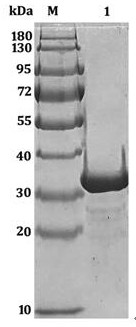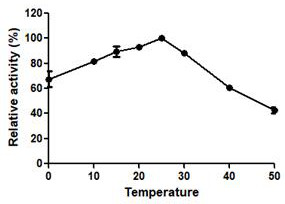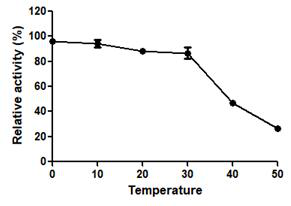A chitosanase csna1 derived from deep-sea microorganisms and its application
A technology of chitosanase and chitosan, applied to microorganisms, methods based on microorganisms, applications, etc., can solve the problems of high price, low activity, and single variety, and achieve the effects of simple preparation, high yield, and novel sequences
- Summary
- Abstract
- Description
- Claims
- Application Information
AI Technical Summary
Problems solved by technology
Method used
Image
Examples
Embodiment 1
[0024] Example 1 Sequence Analysis of Chitosanase CsnA1
[0025] The enzyme-producing gene csnA1 of the chitosanase CsnA1 in the invention is an artificially synthesized sequence. In previous studies, we found that the deep-sea bacterium Vibrio sp. A1-09 has high chitosanase activity. When it was sequenced, it was found to contain a predicted chitosanase sequence, which was named csnA1. Under the condition that the amino acid sequence remains unchanged, we optimized the base sequence of the gene sequence according to the codon preference of the host (Escherichia coli), so as to facilitate its high-efficiency expression in Escherichia coli. The chitosanase CsnA1 of the present invention contains 828 base sequences and encodes 276 amino acid sequences. Using the Conserved Domain (CDD) analysis in NCBI, it was found that the sequence contained a conserved region of the 46th family of polysaccharide hydrolase (GH-46). Multiple sequence comparison Basic Local Alignment Search Too...
Embodiment 2
[0034] The preparation and purification method of embodiment 2 chitosanase CsnA1
[0035] Culture the recombinant strain BL21(DE3) / pET22b-CsnA1 in 100 mL of LB liquid medium (50 μg / mL ampicillin) in a shaker at 37°C at 180 rpm until OD 600 =0.6, add the inducer isopropyl-β-D-thiogalactoside (IPTG) at a final concentration of 0.1 mM, and induce at 20°C for 20 h. The standard assay method for chitosanase CsnA1 activity is: add 900 μL 0.3% chitosan substrate (20 mM acetic acid-sodium acetate, pH=6.0) to 100 μL enzyme solution, react at 25°C for 10 min, add 750 μL DNS reagent was reacted in boiling water for 10 min for color development, and its absorbance was detected at OD520. Enzyme activity is defined as 1 U is the amount of enzyme required to produce 1 μM reducing sugar per min. After testing, the chitosanase activity in the fermentation broth can reach 379.9 U / mL.
[0036] After the fermentation stopped, centrifuge at 12000 rpm for 10 min, discard the bacteria, and collec...
Embodiment 3
[0037] Embodiment 3 The influence of temperature on chitosanase CsnA1
[0038] The purified chitosanase CsnA1 obtained in Example 2 was tested for enzyme activity under different conditions to detect the effects of different temperatures and pH on the enzyme activity. React at different temperatures (0-50°C) for 10 min, detect the effect of different reaction temperatures on enzyme activity, and calculate the relative enzyme activity of chitosanase CsnA1 at different temperatures with the highest enzyme activity as 100%. Such as figure 2 As shown, the optimum reaction temperature of chitosanase CsnA1 is 25℃. The chitosanase CsnA1 of the present invention has psychrophilic properties, and the detection activity at 0°C, 10°C, and 15°C can reach 67.6%, 81.5% and 89.3% of the optimum reaction temperature, which can meet the requirements of low temperature applications. Social needs.
[0039] The chitosanase CsnA1 purified in Example 2 was incubated at different temperatures (0...
PUM
| Property | Measurement | Unit |
|---|---|---|
| molecular weight | aaaaa | aaaaa |
| recovery rate | aaaaa | aaaaa |
| purity | aaaaa | aaaaa |
Abstract
Description
Claims
Application Information
 Login to View More
Login to View More - R&D
- Intellectual Property
- Life Sciences
- Materials
- Tech Scout
- Unparalleled Data Quality
- Higher Quality Content
- 60% Fewer Hallucinations
Browse by: Latest US Patents, China's latest patents, Technical Efficacy Thesaurus, Application Domain, Technology Topic, Popular Technical Reports.
© 2025 PatSnap. All rights reserved.Legal|Privacy policy|Modern Slavery Act Transparency Statement|Sitemap|About US| Contact US: help@patsnap.com



